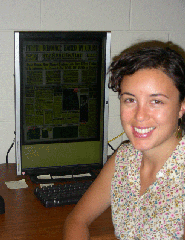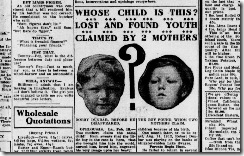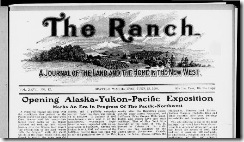How Digitizing is Changing my Life: Ashley Fejeran
From the desk of Rand Simmons
Recently I blogged that we had received an extension on our National Endowment for the Humanities grant to allow us an extension of time to continue to digitize Washington historical newspapers. The project is the National Digital Newspaper Program of the Library of Congress (LoC). Washington State Library’s  contributions appear in Chronicling America.
contributions appear in Chronicling America.
The project requires collaboration between the Washington State Library and the University of Washington Libraries Microfilm and Newspaper department. At UW we have two students helping us evaluate and process necessary metadata for each page posted to LoC’s public website. In our UW office at Suzzallo Library Britta Anson, a doctoral student of history, is helping us with title research for essays that accompany the newspaper titles and Ashley Fejeran, a second year library and information student, will be helping with page evaluation. Ashley took a break in her busy schedule to write about her experience this summer with the Washington program:
Each day, tucked deep in the cozy basement of Suzzallo Library at the University of Washington, my colleagues and I are working to prepare Washington newspapers from the late 1800’s to 1922 for OCR (optical character recognition) software that will make each paper searchable. I am working with the Washington State Library as a part of the National Digital Newspaper Program (NDNP); a project that will digitize many historic newspapers across the United States. Now in the fourth year of the program we are deep in the midst of processing important Washington State newspaper titles. Papers like the Industrial Freedom from the tiny town of Edison, the Yakima Herald, and the Aberdeen Herald are already on their way to being published on the Chronicling America Website which holds over four million pages of already processed papers. Our Washington program has already processed over 25 titles, with more to come in the next two years!
While enrolled in the University of Washington’s Master of Library and Information Science program this project has given me invaluable exposure to the principles of digital librarianship and a new perspective on the age old question of preservation versus access. In classes, forums, and over drinks I’ve had countless discussions on the merits of each with my library colleagues, and I’ve seen my own feelings roam the spectrum between these seemingly disparate ideas. It wasn’t until I started work on the National Digital Newspaper Program that I began to see that it is possible to both preserve historically significant artifacts and offer increased access to these interesting and important documents.
principles of digital librarianship and a new perspective on the age old question of preservation versus access. In classes, forums, and over drinks I’ve had countless discussions on the merits of each with my library colleagues, and I’ve seen my own feelings roam the spectrum between these seemingly disparate ideas. It wasn’t until I started work on the National Digital Newspaper Program that I began to see that it is possible to both preserve historically significant artifacts and offer increased access to these interesting and important documents.
As an aspiring librarian this program has much professional appeal; however, it has become of personal interest to me as well. A few days ago on the radio program This American Life I heard a story about the mysterious disappearance of a little boy named Bobby Dunbar in the summer of 1912. As the story unfolded, the whole nation was captivated by the tragedy of this lost boy and the controversy that ensued with his eventual recovery.
Not long ago (before working on the Washington NDNP project) this story might have just remained an interesting episode of This American Life. Because of the work I’ve been doing on this project, I knew that many of the newspapers from the time of Bobby Dunbar’s disappearance were probably available online. Through Chronicling America I searched for, and found, many articles covering the disappearance of Bobby Dunbar. Reading the story as it was actually reported was fascinating, and brought a new level of depth to what happened for me. These were real people!
 In other, local, news I’ve been reading about the Alaska-Yukon-Pacific Exposition which happened in 1909 on the University of Washington’s campus. The Exposition is considered the precursor to the 1962 Seattle World’s Fair, which is celebrating its 50th anniversary this year. As Seattle paper The Ranch proclaims, “Opening Alaska-Yukon-Pacific Exposition Marks and Era In Progress of the Pacific-Northwest!”
In other, local, news I’ve been reading about the Alaska-Yukon-Pacific Exposition which happened in 1909 on the University of Washington’s campus. The Exposition is considered the precursor to the 1962 Seattle World’s Fair, which is celebrating its 50th anniversary this year. As Seattle paper The Ranch proclaims, “Opening Alaska-Yukon-Pacific Exposition Marks and Era In Progress of the Pacific-Northwest!”
What I do is just one step in a long process; it is exciting that my job is to help make these papers available, so that anyone can read for themselves how an historic story played out. As I fuss with text and image zones, and correct page alignment, not only am I gaining valuable professional experience, I also get to take a look into the daily lives of people living 100 years before me. The discussion of preservation and access will certainly continue, and it is likely that there is no perfect solution, working with Washington’s National Digital Newspaper Program has proved a fascinating look at the possibility for both.